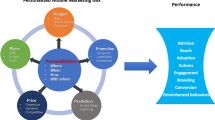Abstract
Product customization is attracting more attentions in industry as a viable strategy to better meet customer requirements and gain more profit. However the vast number of product variants in product customization process often makes it difficult for consumers to make purchase decisions, a phenomenon referred to as information overload. In this paper we take a two-prong approach to tackle the issue of information overload in customized products recommendation. Basically, the method answers two questions, namely, which products to recommend and in what order to present the recommendations. Firstly, a probability relevance model is deployed to calculate the probability of relevance for each end product. Then a probability ranking principle is exploited to present the recommendations. The approach also takes customer flexibility into consideration and thus mitigates the effect of inconsistent specifications from customers. It does not require any prior knowledge about an active customer’s preference and can accommodate the new customers challenge facing by recommendation approaches. Analytical results show that the method is optimal in terms of customer’s utility and product recommendation efficiency. Numerical experiments are also conducted to test the presented approach.
Similar content being viewed by others
References
Aldanondo, M., & Vareilles, E. (2008). Configuration for mass customization: How to extend product configuration towards requirements and process configuration 19(5), 521–535.
Basu, C., Hirsh, H., & Cohen, W. (1998). Recommendation as classification: Using social and content-based information in recommendation. In Proceedings of the 1998 workshop on recommender systems (pp. 11–15). AAAI Press.
Billsus, D., & Pazzani, M. J. (1998). Learning collaborative information filters. In Proceedings of the 15th international conference on machine learning (pp. 46–53).
Breese, J. S., Heckerman, D., & Kadie, C. (1998). Empirical analysis of predictive algorithms for collaborative filtering. In Proceedings of the 14th conference on uncertainty in artificial intelligence.
Chickering, D. M. (2002). The WinMine toolkit. Microsoft Research Technical Report MSR-TR-2002-103.
Chow C. K., Liu C. N. (1968) Approximating discrete probability distributions with dependence trees. IEEE Transactions on Information Theory 14(3): 462–467
Cox, W. M., & Alm, R. (1998). The right stuff: America’s move to mass customization. 1998 annual report of Federal Reserve Bank of Dallas, Dallas, TX.
Crestani F., Lalmas M., van Rijsbergen C. J., Campbell I. (1998) Is this document relevant?…probably: A survey of probabilistic models in information retrieval. ACM Computing Surveys 30(4): 528–552
Croft W., Harper D. (1979) Using probabilistic models of information retrieval without relevance information. Journal of Documentation 35: 285–295
Gordon M. D., Peter L. (1991) A utility theory examination of the probability ranking principle in information retrieval. Journal of the American Society for Information Science 42(10): 703–714
Harper D. J., van Rijsbergen C. J. (1978) An evaluation of feedback in document retrieval using co-occurrence data. Journal of Documentation 34(1): 189–216
Karger, D. R., Klein, P. N., & Tarjan, R. E. (1995). A randomized linear-time algorithm to find minimum spanning trees. Journal of the Association for Computing Machinery, 42(2), 321–328. doi:10.1145/201019.201022 (MR1409738).
Katriel I., Sanders, P., Larsson T., Jesper, T., & Jesper, L. (2003). A practical minimum spanning tree algorithm using the cycle property. In 11th European symposium on algorithms (ESA) (pp. 679–690). LNCS number 2832.
MasColel A., Whinston M., Green J. (1995) Microeconomic theory. Oxford University Press, Oxford
Mavridou, E., Kehagias, D. D, Tzovaras, D., & Hassapis, G. (2011). Mining affective needs of automotive industry customers for building a mass-customization recommender system. Journal of Intelligent Manufacturing. doi:10.1007/s10845-011-0579-4 (accepted).
Moon S. K., Simpson T. W., Kumara S. R. T. (2009) An agent-based recommender system for developing customized families of products. Journal of Intelligent Manufacturing 20(6): 649–659
Peddy C. C., Armentrout D. (2003) Building solutions with microsoft commerce server 2002. Microsoft Press, Redmond, WA
Resnick, P., Iacovou, N., Sushak, M., Bergstrom, P., & Riedl, J. (1994). GroupLens: An open architecture for collaborative filtering of Netnews. In Proceedings of the 1994 computer supported collaborative work conference.
Ripley B. D. (1996) Pattern recognition and neural networks. Cambridge University Press, Cambridge
Risdiyono, & Koomsap, P. (2011). Design by customer: Concept and applications. Journal of Intelligent Manufacturing. doi:10.1007/s10845-011-0587-4 (accepted).
Shardanand, U., & Maes, P. (1995) Social information filtering algorithms for automating ’Word of Mouth’. In Proceedings of CHI’95.
Simon H. H. (1957) Models of man. Wiley, New York
Stormer H. (2009) Improving product configurators by means of a collaborative recommender system. International Journal of Mass Customisation 3(2): 165–178
van Rijsbergen C. J. (1979) Information retrieval. Butterworths, London
Wang, Y., & Tseng, M. M. (2009). Recommendation for custom product via probabilistic relevance model. In Proceedings of IEEE conference on engineering management, Hong Kong.
Wang Y., Tseng M. M. (2011) Adaptive attribute selection for configurator design via Shapley value. Artificial Intelligence for Engineering Design, Analysis and Manufacturing 25(1): 185–195
Wright P. (1975) Consumer choice strategies: Simplifying vs. optimizing. Journal of Marketing Research 12(February): 60–67
Zhang T., Iyengar V. S. (2002) Recommender systems using linear classifiers. Journal of Machine Learning Research 2(1): 313–334
Zhu, X., Hu, S. J., & Yoram, K. (2008). Modeling of manufacturing complexity in mixed-model assembly lines. Journal of Manufacturing Science and Engineering, 130(5).
Author information
Authors and Affiliations
Corresponding author
Rights and permissions
About this article
Cite this article
Wang, Y., Tseng, M.M. Customized products recommendation based on probabilistic relevance model. J Intell Manuf 24, 951–960 (2013). https://doi.org/10.1007/s10845-012-0644-7
Received:
Accepted:
Published:
Issue Date:
DOI: https://doi.org/10.1007/s10845-012-0644-7




